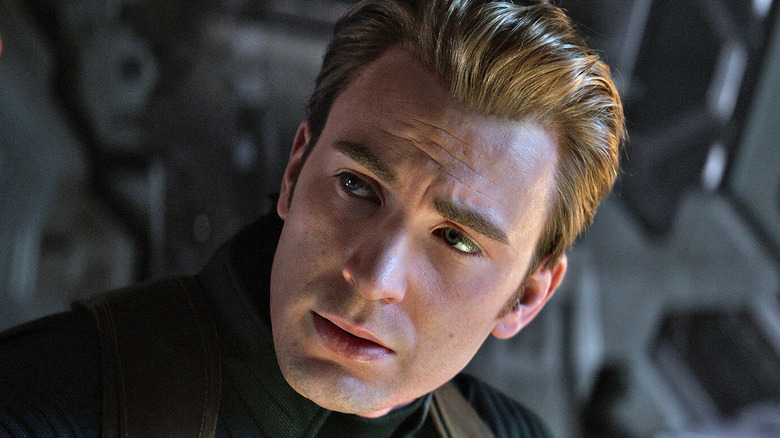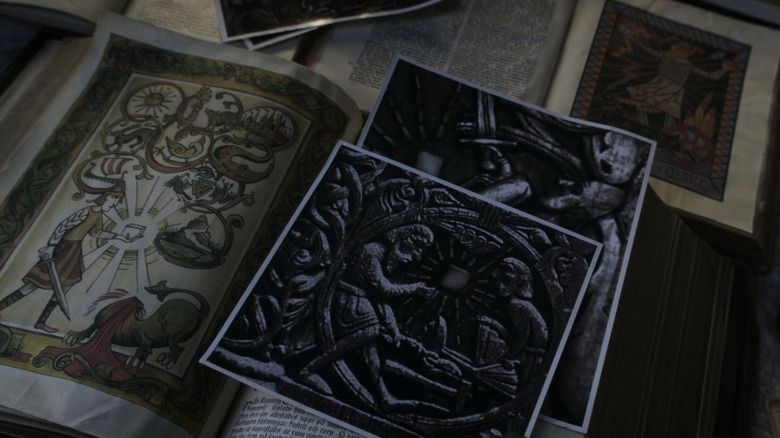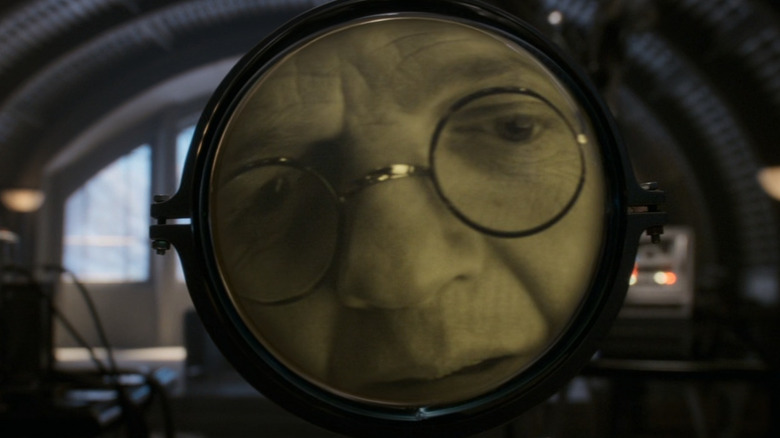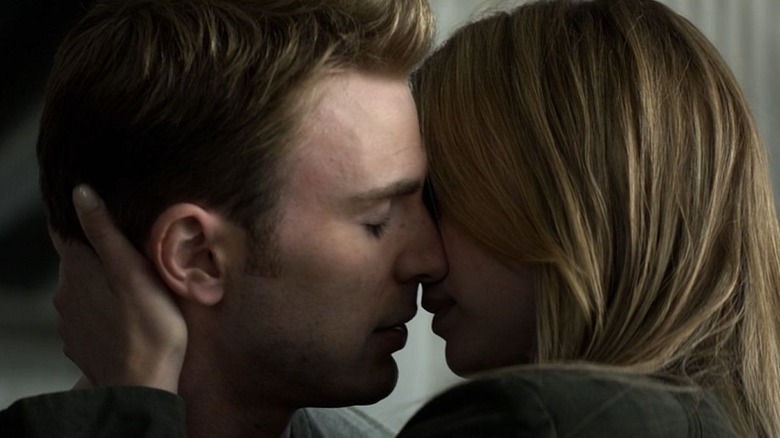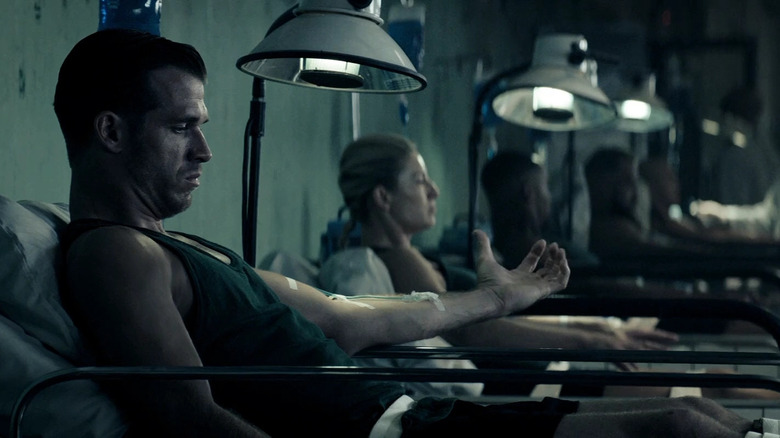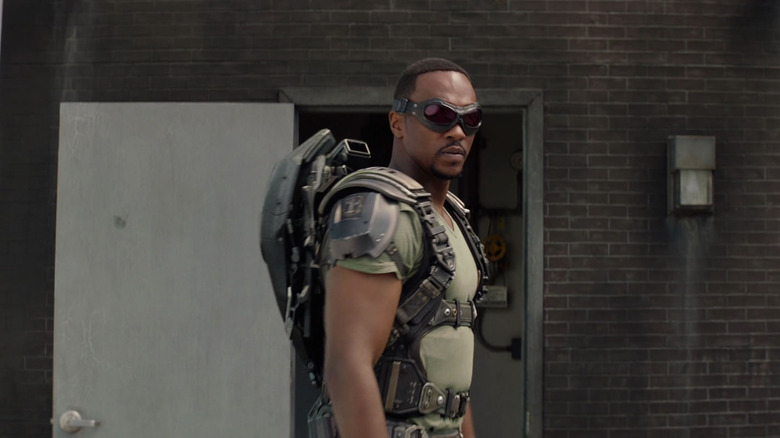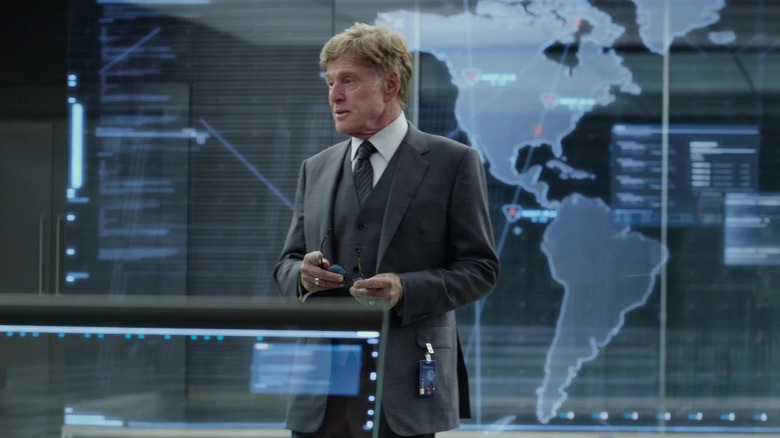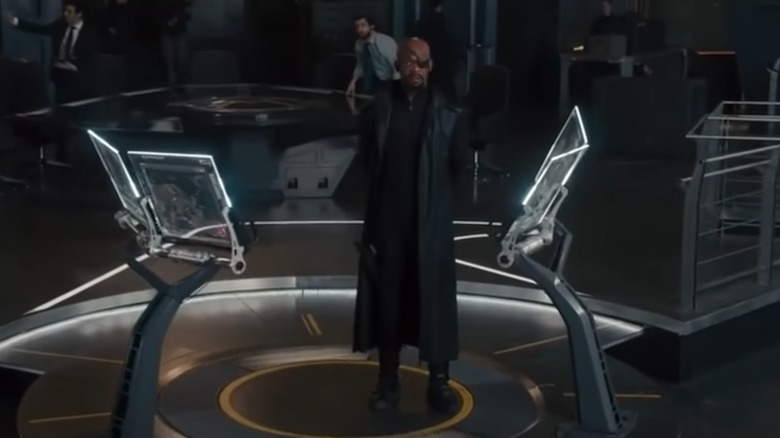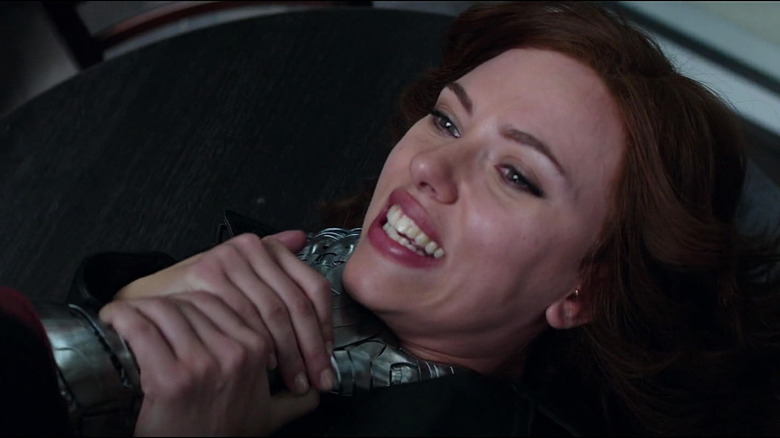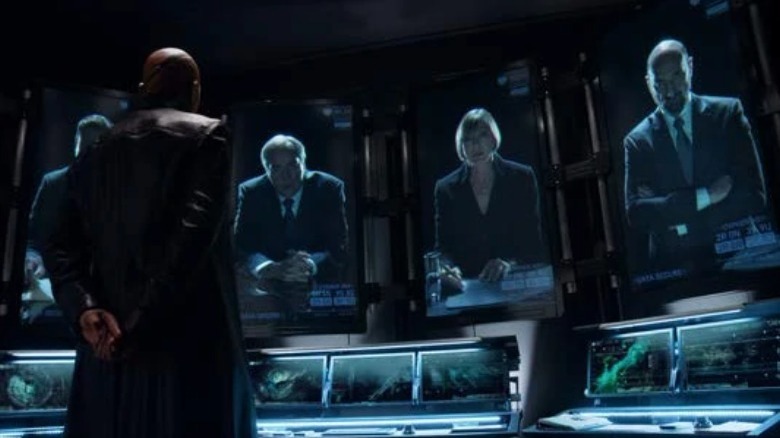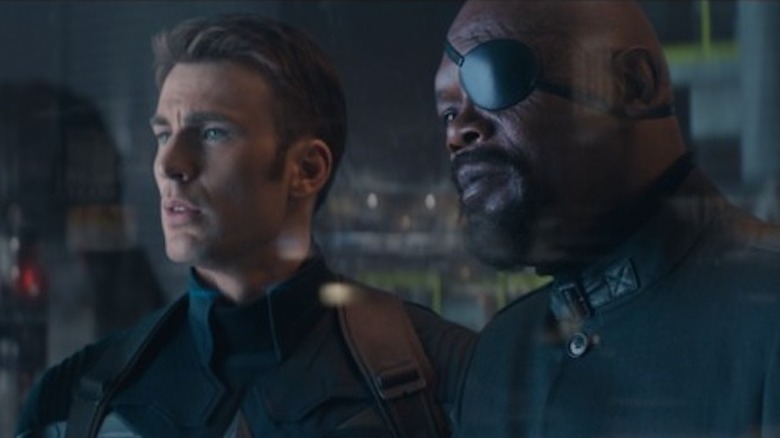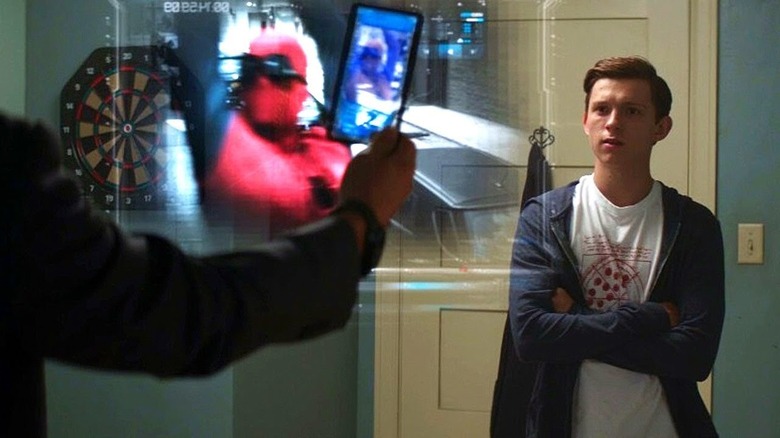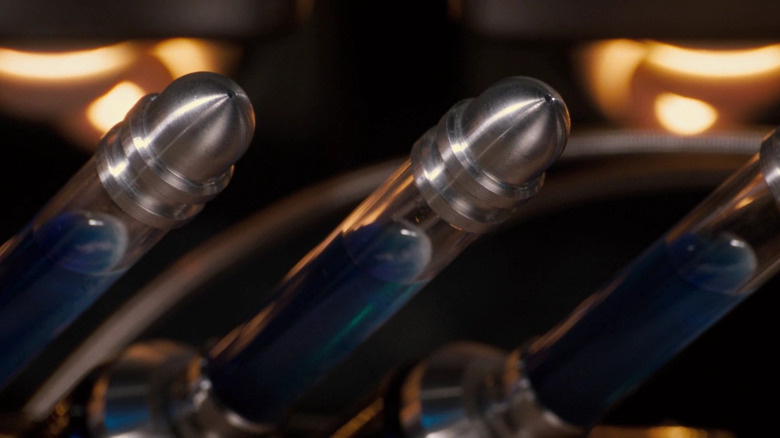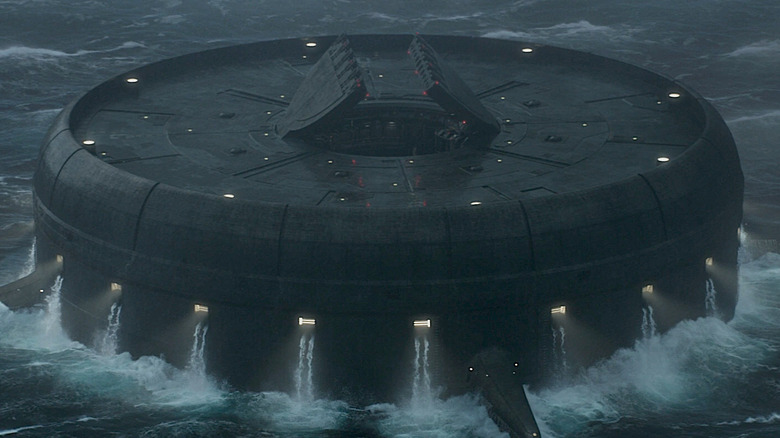Biggest Unanswered Questions From The Captain America Trilogy
One of Marvel's marquee heroes, Captain America, had to wait decades to hit the big screen after Hollywood had already given Spider-Man, Hulk, the X-Men, and Iron Man a shot first. However, his debut in "Captain America: The First Avenger" was more than just a set-up for the "Avengers" film. Set entirely during World War 2, it was a thrilling pulp-inspired adventure that told the story of underdog Steve Rogers, who volunteers for an experimental procedure that turns him into a super-powered soldier.
After defeating the Red Skull, Rogers crashes in the Arctic and is frozen in ice, where he lays dormant for more than 60 years before being unearthed in the 21st century. After leading the Avengers in stopping an alien invasion, Rogers would return in "Captain America: The Winter Soldier," where he'd go toe-to-toe with a mysterious Soviet-era assassin before learning his enemy was his old friend Bucky Barnes.
The threequel "Captain America: Civil War" sees Bucky on the run and Rogers out to save him while the world's governments debate over whether to allow the Avengers to operate as an independent group of vigilantes. Ultimately, the three films comprise one of the best superhero trilogies in cinema, but they're not without their unfinished plotlines. While some elements were resolved elsewhere — such as in "Avengers: Endgame" and the Disney+ series "The Falcon and the Winter Soldier" – we're still left with a handful of questions that went unanswered by the "Captain America" trilogy.
The history of the tesseract
The first "Captain America" film begins with Nazi leader Johann Schmidt arriving in a Norwegian village where he believes a powerful and ancient alien relic is hidden. He's right, of course, and after a brief investigation he uncovers a cosmic cube — the Tesseract — which he describes as the jewel of Odin's treasure room. Unbeknownst to all, however, is that the Tesseract is one of the six Infinity Stones. Each stone gives its wielder incredible power, and when all six are assembled it makes them a god, as Thanos achieved in "Avengers: Infinity War." But how did the Tesseract get to Earth, and what became of it in the centuries before it was found by Schmidt?
It's believed that Odin left the Tesseract on Earth believing it would be safer on the backwater planet than in his vault. However, images in "Captain America: The First Avenger" indicate its history on Earth involved much more than just being hidden in a wall waiting for Red Skull to find it.
Leafing through history books, Schmidt studies historical imagery of the cube being passed to humans by Odin himself. Was the Tesseract once used as a weapon in Earth wars centuries ago? A decoy of the cube was buried with a Norwegian knight of some stature, suggesting that the real cube may have been wielded at some point by an Earthly king. Whatever the case, Odin was clearly misguided if he believed Midgard was the safest place to keep the Infinity Stone.
Is Arnim Zola still out there?
In "Captain America: The First Avenger," Arnim Zola is introduced as the brains behind HYDRA. After the fall of the Red Skull, Zola defects to the United States, joining the nascent organization called SHIELD. Over time, Zola becomes one of their leading scientific minds, and in "Captain America: The Winter Soldier" we learn that he eventually develops an algorithm to predict the future. Specifically, he could identify individuals who could threaten world order, and SHIELD — having been take over from within by HYDRA — uses it to plan world domination. In the film, Captain America and Black Widow meet a computerized version of Zola at Camp Lehigh, who transferred his consciousness into a computer after his death. Zola bombs the facility, apparently destroying himself with it.
It seems unlikely that Zola would have ordered the destruction of the only copy of himself, given how much he'd done to survive in World War 2 and beyond. It seems much more likely that the 1980s era computer version of Zola was merely an older backup copy, and newer, more advanced copies may lay elsewhere. This artificially intelligent program, perhaps loaded into an android body, could be out there somewhere. In fact, in an animated "What If...?" episode set in an alternate reality it's said that Zola has a backup copy in Siberia. Perhaps something similar is true in the prime MCU timeline as well.
Sharon Carter's romance with Captain America
After his flirtations and unfulfilled courtship with Peggy Carter in "Captain America: The First Avenger," Steve Rogers is awoken in the 21st century with few romantic prospects. In "Captain America: The Winter Soldier" Rogers shows interest in the woman across the hall from him before the film's plot really kicks in and he goes on the run from SHIELD. He later learns that the woman was none other than Sharon Carter, a descendent of Peggy. In the comics, Sharon is Peggy's niece, but in the MCU it's not made precisely clear how the two are connected.
Regardless of the specifics, things get more complicated for Steve in "Captain America: Civil War" when he and Sharon share a passionate kiss after she helps him assemble his new team. While it is assumed that Sharon would suit up and join him, she winds up only playing a small role in the film. Of course, Steve ends up living out the rest of his life with Sharon's ancestor Peggy in "Avengers: Endgame" — making that kiss awfully awkward in hindsight.
Fast forward to the present day in the MCU, and an elderly Steve Rogers is apparently retired, while Sharon might be a full-on supervillain, as revealed in "Falcon and the Winter Soldier." So whatever happened to their budding romance? Perhaps Steve running off with her grand-aunt is what set Sharon down a dark path.
Other super soldier serums
We know in the MCU that Johann Schmidt was the first subject of Erskine's super-soldier serum before it was perfected for use on Steve Rogers. However, could there have been others who received the serum before Schmidt? Could there have been others after Schmidt but before Rogers? After Erskine's death, we see HYDRA use the serum in the Winter Soldier program. Beyond that, it is explained in "Captain America: Civil War" that it works on Bucky, and not others, because he had first been exposed to Arnim Zola's version of the serum during captivity in 1943.
What about others who may have been exposed during that time? If Zola's formula was good enough to help turn Bucky Barnes into the Winter Soldier, did he ever use it on anyone else? We know that the United States continued experimenting with the super-soldier serum and that Isaiah Bradley was a successful test subject in the 1950s. We also see Bruce Banner's gamma-ray treatment — another attempt at creating a super soldier — turn him into the Hulk, and still another version that made Emil Blonsky the Abomination. However, there are still many years of MCU history unaccounted for when other super-soldiers may have been created.
With so many versions of the serum floating around, it seems likely that it wasn't just the United States Government and SHIELD who were trying to make super soldiers. Could there have been other groups out there trying to create their own Captain America?
The Falcon suit
Unlike Iron Man, Ant-Man, or War Machine, Sam Wilson's superhero suit isn't made from some privately funded, super-advanced technology developed by an independent genius. Instead, the Falcon's wingsuit — designated EXO-7 — is designed and built by the U.S. government, and it isn't issued to him for superheroics. It is stolen. With Cap's help, Wilson and Black Widow break into Fort Meade, make their way past armed guards, and procure it for themselves.
In "Captain America: The Winter Soldier," Wilson notes the wingsuit they've stolen is the last one, and by the end of the film the suit is destroyed during his battle with HYDRA and the Winter Soldier. We assume that the Avengers — or perhaps Tony Stark himself — rebuilt it with added gadgetry seen in "Captain America: Civil War," but we still have some lingering questions about the original.
Did Wilson face any consequences for stealing it? Did the government — having seen it used to great effect by Wilson in the battle with HYDRA — commission more for deployment by modern soldiers in combat? Given that it went on to be used by one of Earth's mightiest heroes, it stands to reason the Army or Air Force might want to use them to create entire winged platoons for air combat, rescue missions, and more.
How did SHIELD become HYDRA?
The second film in the series, "Captain America: The Winter Soldier," reveals that HYDRA was never truly defeated — it simply took on a new form. Through Operation Paperclip, HYDRA scientist Arnim Zola joins American forces and becomes a leading SHIELD scientist, presumably alongside the likes of Howard Stark and Hank Pym. Somehow, Zola is able to resurrect his old evil organization within SHIELD itself, with some of its highest-ranking members serving in the former Nazi science division. Even prominent American politicians are discovered to have been secret HYDRA agents, suggesting that their influence goes far beyond the agency.
However, one rather large question remains: how exactly did that happen? We can't imagine that Zola, who describes himself as a mere scientist and designer of weapons in "Captain America: The First Avenger," was the one to amass supporters and bring back his old organization. There must have been others from HYDRA whose influence and power were even greater who slowly recruited agents one by one until, eventually, there were nearly as many HYDRA agents as SHIELD agents.
Beyond that, how could some of SHIELD's most prominent and powerful leaders have no idea about the presence of enemy agents in their midst? From Hank Pym and Howard Stark right up to Nick Fury, it seems they are all hoodwinked. Ultimately, the growth of HYDRA inside SHIELD is not just a question mark, but a plotline ripe to be explored.
What is Fury doing after SHIELD?
In "Captain America: The Winter Soldier" HYDRA agents within SHIELD go to war with the agents who are still on the side of good, including Nick Fury. In the end, Fury triumphs, stopping HYDRA's Project Insight, which is a plan to launch three massive helicarriers to patrol the skies. However, SHIELD and Fury still lose in the aftermath because the agency comes crumbling down and is ultimately dissolved.
In subsequent MCU installments Fury keeps busy, and in "Age Of Ultron" he still seems to have a group of SHIELD agents loyal to him. With the agency itself no longer up and running, how exactly is he operating? Over on the ABC series "Agents Of S.H.I.E.L.D." it is stated that the agency was rebuilt, but that seems separate from Fury's affairs.
So how is Fury operating after the fall of SHIELD in "Captain America: The Winter Soldier"? Does he have his own privately funded agency that includes agents and equipment taken from the remnants of SHIELD to help him in further private missions? It would certainly seem so. Perhaps we'll finally get some clarity in Fury's appearance alongside the Skrulls in the Disney+ miniseries "Secret Invasion."
Black Widow's history with the Winter Soldier
Before Natasha Romanov became a SHIELD agent, she served the Russian state as part of the covert ops Black Widow program for years. In "Captain America: The Winter Soldier," Romanoff has the inside intel on the mysterious masked mercenary gunning for Captain America, describing him as a "ghost story" responsible for several major assassinations. Later, it is revealed that the mercenary is none other than Steve Rogers' old friend Bucky Barnes, who HYDRA agents have brainwashed.
In the sequel, "Captain America: Civil War," Romanoff and Barnes come face to face in Germany after Baron Zemo helps him escape the clutches of the U.S. government. While going one-on-one with Barnes, Natasha says, "You could at least recognize me." Given her knowledge of the Winter Soldier and her past work for the Russian government, it's suggested that Romanoff and the Winter Soldier have a history. Despite Black Widow starring in her own feature film that dipped deep into her past, we still have yet to discover just what her history with him might be.
In the comics, the two were long-time partners and even lovers, but in the MCU, there's no such evidence. Considering Romanoff's fate after the events of "Avengers: Endgame," this is one question that may go unanswered.
What became of the World Security Council?
Throughout the events of "The Avengers" and "Captain America: The Winter Soldier," the super-team led by Captain America operates as a part of SHIELD. Meanwhile, SHIELD operates under the guidance of the World Security Council. However, after SHIELD falls, we never heard from the council again, despite the Avengers continuing to essentially operate as an independent peace-keeping force.
Following a pitched battle in South Africa in "Avengers: Age Of Ultron," there is worldwide condemnation of the Avengers that sends the team off the grid to regroup. Why were the Avengers allowed to operate independently, and what happened to the World Security Council?
In fact, in "Captain America: Civil War," when the governments of the world finally agree that the Avengers should have some form of oversight, the U.N. is put in charge. So what happened to the World Security Council? Made up of leaders from key nations around the globe, they seem like an ideal body to keep tabs on The Avengers. In contrast, a wide-ranging organization like the United Nations seems far too bureaucratic to effectively manage a team of global superheroes.
Where was Nick Fury during the Civil War?
The "Captain America: Civil War" tells a story that splits the Avengers in two and pits Steve Rogers and Tony Stark against one another. Nearly every Avenger appears in the film, with a few notable exceptions. While the reason for Thor and Hulk's absence from the story was shown in "Thor: Ragnarok," Nick Fury's absence in "Civil War" is never explained.
As the man responsible for bringing the Avengers together in the first place, you'd think Fury would have something to say about the conflict. When General Ross tells the team about the Sokovia Accords, Fury is silent, and when Captain America goes rogue to save the Winter Soldier, he once again has nothing to say. Even when Stark and Rogers lead two opposing teams of heroes into battle against each other — including one of Fury's closest confidantes, Natasha Romanoff — the former Director Of SHIELD stays out of the fray.
So where is Nick Fury while the events of "Captain America: Civil War" are occurring? With so much at stake, and considering his close ties to both the team and its individual members, you'd think somebody would reach out if for no other reason than to get some advice. Instead, he's a complete no-show.
How long was Tony Stark aware of Spider-Man?
In "Captain America: Civil War," Tony Stark needs reinforcements to face down Steve Rogers and his team of upstart Avengers, so he calls in a new recruit. No, it's not a longtime hero, but high schooler and part-time vigilante Peter Parker, aka Spider-Man.
When Tony meets Peter, the amateur superhero claims to have only been Spider-Man for about six months and reveals that he doesn't have a proper superhero suit. However, considering the fact that Tony already knows his secret identity and has a new outfit ready for Peter in under 24 hours, Stark must have been keeping an eye on him for some time. It's never said how long or why the New York vigilante was even a person of interest for Tony. Why would Stark be keeping tabs on a low-level street hero, anyway? Was he considering Parker as an Avengers recruit even before the events of "Captain America: Civil War?"
Now that Spider-Man has three of his own feature films alongside appearances in two "Avengers" movies, it's surprising this question hasn't been answered already.
Who was Howard Stark's revised serum intended for?
The source of the conflict between Steve Rogers and Tony Stark in "Captain America: Civil War" is about much more than their disagreement over the Sokovia Accords. When it is revealed that the Winter Soldier killed Tony Stark's parents in a HYDRA hit in the early '90s, Tony wants Bucky's blood. This causes an irreconcilable schism between the two teammates. The assassination took place in 1991 and was carried out during the hijacking of a shipment of Stark's revised super-soldier serum, which HYDRA planned to use to create more Winter Soldiers.
However, one question that is never answered is who the serum carried by Stark was initially intended for. Beyond its original recipient, was there more serum in his lab or at SHIELD? It's hard to believe Stark would keep the sole vials of serum — a precious commodity — in an unsecured trunk of a civilian sedan. Assuming there was more serum and there was an active Super Soldier Program within SHIELD at that time, it stands to reason there could very well have been others like Captain America and Isaiah Bradley created by SHIELD in the 1990s. No such soldiers have yet to be referenced in the MCU, however.
Are Marvel's biggest villains in the Raft?
At the conclusion of "Captain America: Civil War," Tony Stark's side wins the conflict, with many on Steve Rogers' team taking the fall to allow him to save Bucky. The end of the film provides a capper on the proceedings as it shows Scott Lang, Clint Barton, Wanda Maximoff, and Sam Wilson being taken into custody and placed into a super-max prison called the Raft.
Located below the ocean in the middle of the sea, the facility features some of the most advanced security technology, and its remote, underwater location makes it nearly impenetrable. Nevertheless, Captain America and Bucky are able to break in and free their teammates, teasing their next appearance in "Avengers: Infinity War."
The nature of the Raft seems to lend itself to the idea that it could be home to the MCU's most dangerous super-criminals. Though most early MCU villains were either killed, like Ivan Vanko, taken off-planet, like Loki, or mysteriously disappeared, like Red Skull, many have speculated about one notable baddie who could have been housed in the Raft: Emil Blonsky, aka the Abomination. While it's not said in the film if there are any other prisoners in the Raft, we have to imagine that it wasn't just built for the Avengers. It more likely was constructed for any super-powered, high-security risk individual, and Abomination certainly qualifies. With Blonsky appearing in the Disney+ series "She-Hulk," we may finally find out if that was the case.
